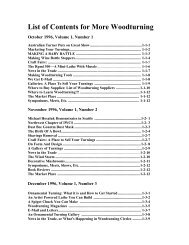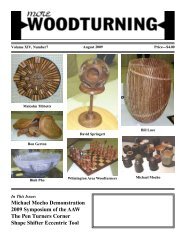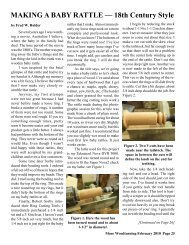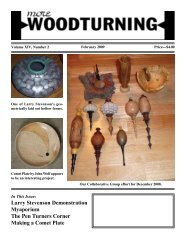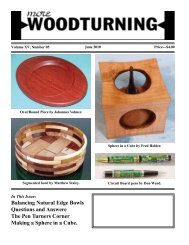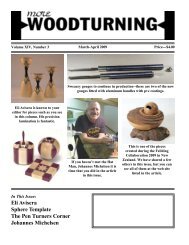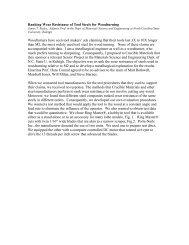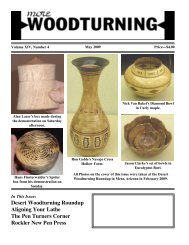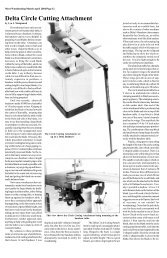Two New Shear Scrapers - More Woodturning
Two New Shear Scrapers - More Woodturning
Two New Shear Scrapers - More Woodturning
Create successful ePaper yourself
Turn your PDF publications into a flip-book with our unique Google optimized e-Paper software.
<strong>Two</strong> <strong>New</strong> <strong>Shear</strong> <strong>Scrapers</strong><br />
by Lyn J. Mangiameli<br />
[Editor’s Note: This article is an update of the original version published in <strong>More</strong><br />
<strong>Woodturning</strong>, September/October 2002, Page 12.]<br />
<strong>Shear</strong> scraping has become a staple in the repertoire of techniques of the bowl and hollow<br />
form turner. Initially the tools for these techniques were homemade, with Del Stubbs<br />
being one of the first to describe how to use shear scraping techniques and how to make<br />
the tools required. The early tools were intended for use on the exterior of turnings. Later,<br />
commercial variations were developed for application inside hollow forms and bowls,<br />
the most notable early providers of these specialized shear scraping tips coming from<br />
Dennis Stewart in the US and Robert Sorby in the UK. They work well and have<br />
spawned many imitators, most of which have I commented on in my surveys of<br />
hollowing tools that are available at the <strong>More</strong> Woodturing website:<br />
http://www.fholder.com/<strong>Woodturning</strong>/woodturn.htm<br />
<strong>Two</strong> <strong>Shear</strong> <strong>Scrapers</strong>: Kelton Tool on Top and the Woodcut tool on the bottom.<br />
Recently I have acquired two new shear scrapers, one from Kelton and one from<br />
Woodcut. The two could not be more different, yet I have found both to be outstanding<br />
for their intended use. The Kelton has been on the market longer, and uses a thick, one<br />
inch wide, round nosed, replaceable tip which is bolted to the slotted end of a straight,<br />
very heavy, almost 20 inch shaft (2.75 inches of which is tang). I have not yet used one,<br />
but also available is a 5/8 inch tip and a 10 inch shaft (again 2.75 inch of which is tang);<br />
these can be used together as a smaller assembly, or individually can be substituted for<br />
the corresponding portion of the larger shear scraper. You can also mount the Kelton<br />
Hook tip in either shaft. The shafts, regardless of length, are approximately 7/8 inch<br />
(22mm) in maximum diameter, necking down to a 16 mm diameter tang for insertion into<br />
a steel handle. Their tang does not fit into true 5/8 inch ID handles such as those from<br />
Hamlet, and Woodcut, but does fit in the Oneway and Kelton handles which are often<br />
identified as having a 5/8 inch socket but actually have slightly larger 16 mm sockets.<br />
When I first received the Kelton shear scraper I though it was overkill. This scraper is<br />
long (total usable length with scraper tip is 18 inches), heavy, and rather industrial<br />
looking with a big hex head bolt used to lock the scraper tip to the shaft. I wondered why<br />
I would want to wrestle this tool around when I had several others to use. Well, I found
out why. That long heavy shaft is incredibly rigid and does a wonderful job damping the<br />
vibration that sometimes develops during scraping. One can hang this tool well over the<br />
tool rest and not regret it—though you are going to want a long weighted handle to feel<br />
fully in control. The long Kelton handle, or jointing a couple of smaller handles together<br />
with some brass or steel rod (such as the large and small Oneway handles) proves to be<br />
just right for me.<br />
The large massive tip is equally solid and can take very heavy cuts with no ill effects.<br />
One gets the feel that with a big enough burr you could actually hollow out a bowl using<br />
this scraper alone if you wanted to. That is not to say that, despite its size, this tool is not<br />
capable of taking very fine shavings, as it very much can. Indeed the stability and<br />
damping that comes from all its weight actually makes achieving fine delicate cuts easier<br />
than with many smaller, lighter scrapers. Like with all shear scrapers, a pulling technique<br />
should be utilized, for the inside of bowls this will mean going from center to rim.<br />
The shaft is asymmetrical in cross section, with one half composed of two flats that will<br />
allow the cutting tip to be easily maintained at a consistent 50 degree angle well suited<br />
for shear scraping (the latter has been one of the things I have always liked about the hard<br />
to find dedicated shear scrapers Sorby offers). The other half of the shaft is smoothly<br />
rounded on the long shaft allowing one to achieve the precise amount of rotation desired,<br />
thus angling the scraper tip is easy to do when desired. The shorter shaft has a medium<br />
sized flat located in the middle of the rounded section. You choose which surface, angled<br />
or hemispherical, (and also flat on the short shaft) you wish to ride on the tool rest, and<br />
then install the scraper tip in the slotted end of the shaft, accordingly.<br />
Kelton Scraper Profile.<br />
Diagram courtesy Lee Valley<br />
©Copyright by Lee Valley Tools Ltd. and Veritas® Tools Inc.<br />
Fine tuning of scraper position is possible by loosening the hex headed bolt and pivoting<br />
the tip towards one side of the shaft, though one would be wise to be very conservative in<br />
how much the tip is pivoted, too much and you will decrease the shearing angle, make<br />
the tip prone to catch and generate torsional forces. The manufacture says the scraper can<br />
be used for external scraping as well (and the side of the shaft with angled flats would be<br />
handy for this), but personally I will probably continue using a bowl gouge or a skewed<br />
edge scraper specifically intended for external shear scraping. Of course you could grind<br />
a spare Kelton tip in a similar straight skewed fashion and likely do as well.
I have no idea what the Kelton scraper blade is made from, but I can say it will hold a<br />
burr for a long time. Coarser burrs, such as those straight off the grinder, can be used for<br />
aggressive wood removal. Finer burrs for final finish cuts are best made using a slip stone<br />
or rolled with a scraper burnisher (the Lee Valley Turning Scraper Burnisher works well<br />
for this). Kelton recommends, and I agree, that having two tips might be handy, with one<br />
tip prepared with a fine burr and another with a coarse burr. However, my experience is<br />
that even with a coarse burr, a gentle application of the tool will allow for very fine wispy<br />
shavings. Though I am mostly a hollow form turner and the Kelton is best suited for<br />
medium to large bowls or open vases, I just love this tool and would not want to be<br />
without it.<br />
The new Woodcut “Pro Scraper” is the antithesis of the Kelton in every respect but<br />
performance. The Woodcut Proformes are known to many turners as highly efficient<br />
deep hollowing tools. The Proforme uses a guarded cutter head assembly that is fitted to<br />
one of three styles of 5/8 inch shaft (straight, angled, swan necked). The shaft is then<br />
mounted in ones choice of steel handles. The Woodcut handle most commonly used with<br />
them is of moderate length, and covered with a dense foam rubber that I find to be<br />
particularly comfortable. Woodcut offers an “intermediate” and long handle as well; and<br />
of course you can use competitors’ handles, such as the Oneway, Hamlet, Exocet or<br />
Kelton. What Woodcut now offers is a scraper companion to the cutting head. This new<br />
shear scraping head will mate to the Proforme shafts in the same way as the cutter head<br />
(just slide it into the end of the shaft and tighten a set screw), and allows one to mount<br />
any of several differently shaped scraper tips (round, pear shaped, asymmetrical tear<br />
drop, etc.). By making use of the same shafts and handles used by the cutter heads, the<br />
Pro Scraper head makes for a very cost effective means to add shear scraping abilities for<br />
those who already own the Proforme hollowing system. For those who do not, or who<br />
simply wish to have a complete tool always at hand, the necessary shaft and handle can<br />
be purchased separately.<br />
The Pro Scraper head originally came with only a relatively thin, mostly round scraper<br />
bolted to its top surface. This scraper tip is fine for delicate small scale work, and will be<br />
very difficult to catch or otherwise get in trouble with during blind scraping. However,<br />
when working with hollow forms, particularly when trying to smooth away ridges, my<br />
favorite style of shear scraper tip is the asymmetrical teardrop that long has been the<br />
standard shear scraper available for Sorby and Stewart tools (and copied by many others).<br />
Woodcut now provides this style of tip with the tool (you now get both tips), but at the<br />
time when I obtained my Pro Scraper head it was not available. My solution was to<br />
simply mount the Sorby and Stewart teardrop tips (the Sorby is somewhat larger, the<br />
Stewart is probably most appropriate to the scale of the Woodcut head), which easily fit<br />
on the Pro Scraper head and are both a little thicker than what Woodcut offers. Thus, the<br />
Woodcut Pro Scraper allows you to access a wide variety of scraper tips, both from<br />
Woodcut and from others.<br />
My preferred shaft for use with the scraper head is the re-introduced canted, “slightly<br />
bent” shaft (it is also my favorite shaft for use with the cutting heads as well). This seems<br />
to allow the scraper tips the best access to the inside of most hollow and open forms.
However, since the Pro Scraper can fit into any of the three Proforme shafts, not only do<br />
you have a lot of choice as to the best way to present the scraper head inside your<br />
turning, but, if our original cuts were made using Proforme tools, you can use the shaft<br />
that coincides with the one you used to make your initial cuts. It is this latter point that I<br />
want to stress. Upon using the Pro Scraper, I immediately found myself more<br />
comfortable and confident blind scraping within hollow forms. It did not take long for me<br />
to realize the reason for this was that I already understood the relationship of the tool to<br />
the internal shape of the form, and was now able to draw on that understanding to guide<br />
my shear scraping cuts. That is, by scraping with a tool of the same length, weight and<br />
shape as I had used for my hollowing cuts, I already understood how the tool needed to<br />
be positioned and what that should feel like. To a certain extent, Stewart System users<br />
have always had this, being able to mount one tip or another on the end of their Hooker<br />
or Omnitool; now Proforme users can have the same advantage. I can not stress enough<br />
how much of a difference this makes, yet it was a totally unanticipated feature of the new<br />
scraper head. Simply, the new ProScraper is by far my preferred shear scraper for small<br />
to medium sized hollow forms.<br />
So I am now in shear scraper heaven. Though I have a Ray Key dual angle shear scraper,<br />
I am usually content to use bowl gouges for external shear scraping. My old Sorby shear<br />
scrapers (the RS200KT Multitool and the small dedicated square shank scrapers) will still<br />
see occasional duty for small boxes and less complex forms. Asymmetrical tear drop<br />
style shear scraper tips fitted to my Hooker and Omnitool style shafts (be they the<br />
Stewart, Sorby or Pencil versions), and the deeper bars I use for the Jamieson and Kelton<br />
restrained rigs will still work best for large or very deep hollow forms. But for small to<br />
medium sized hollow forms, the ones I most enjoy making, there is no doubt for me that<br />
the Woodcut Pro Scraper has become my shear scraping tool of choice, and will replace<br />
using shear scraping tips mounted to the Stewart Pistol handle. The Woodcut Pro Scraper<br />
has subtly but significantly improved the ease and control of my blind shear scraping.<br />
And finally, for use with medium to large bowls and open vases, I have never used a<br />
shear scraper that even approaches the performance of the Kelton. So on one hand, the<br />
news is that there is no one best shear scraper for use in all situations, but on the other, I<br />
find it very pleasing to report that with these new additions, there is now an excellent<br />
shear scraper for whatever specific style or size of turning might be your preference.<br />
Sources:<br />
Kelton <strong>Shear</strong> Scraper:<br />
Lee Valley http://www.leevalley.com<br />
Woodcraft http://www.woodcraft.com<br />
The Woodtradesman http://www.thewoodtradesman.com<br />
Woodcut Pro Scraper:<br />
Craft Supplies http://www.woodturnerscatalog.com<br />
Woodcut<br />
http://www.woodcut-tools.com



